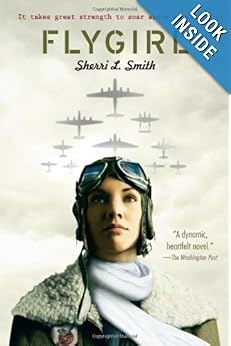 What an inspiring and absorbing book! Ms. Smith writes about Ida Mae Jones, a self-identified “colored girl” who is light-skinned enough to pass for white. The book begins in late 1941, and of course, that means Pearl Harbor, and World War II. Ida Mae learned to fly airplanes from her daddy, who was a crop duster. So when she hears that the U.S. Army has formed a group called the WASPs, Women Airforce Service Pilots, Ida Mae Jones is determined to sign up, even though she lives in Louisiana and the training is to take place in Sweetwater, Texas, two places where the very idea of a young black woman serving alongside white women is sure to be anathema. So in order to get into the WASP’s, Ida Mae basically pretends to be white.
What an inspiring and absorbing book! Ms. Smith writes about Ida Mae Jones, a self-identified “colored girl” who is light-skinned enough to pass for white. The book begins in late 1941, and of course, that means Pearl Harbor, and World War II. Ida Mae learned to fly airplanes from her daddy, who was a crop duster. So when she hears that the U.S. Army has formed a group called the WASPs, Women Airforce Service Pilots, Ida Mae Jones is determined to sign up, even though she lives in Louisiana and the training is to take place in Sweetwater, Texas, two places where the very idea of a young black woman serving alongside white women is sure to be anathema. So in order to get into the WASP’s, Ida Mae basically pretends to be white.
A lot of the book is about the training and the dangers these pioneering women pilots faced as they bravely gave themselves and their abilities to the war effort. I don’t know much about flying airplanes, so although I thought the parts of the book that described the training and the women’s heroics were wonderfully written, I don’t know how accurate they were. I assume Ms. Smith did her research since the book Flygirl started out as a master’s thesis.
Another aspect of the book is the discussion and treatment of race and skin color. I thought this was fascinating, especially in light of recent discussions in the kidlitosphere. What does it mean to be black or to be a person of color? How do POC themselves see the variations in skin color? Is it wrong to pretend to be white and leave your darker-skinned family and friends behind? Even for a good cause?
One of the scenes in the book reminded me of Esther in particular. Ida Mae, like Esther has hidden her heritage and her connection with her people, but she is asked by her mother to go to the military authorities and ask for help in finding her brother who is MIA. Ida Mae knows that if she asks about her brother, she may be discovered and sent home. Her story doesn’t exactly parallel Esther’s, but it is similar. And Ida Mae shows similar courage.
All the issues, discrimination against women and against people of color, the varied reasons that people have for volunteering to fight in a war, misunderstandings and rifts between family members and friends, the cost of following one’s dreams, are explored with both sensitivity and humor. I would recommend this book to all young women who are in the middle of deciding who they are and what they want to be. And as an older woman, I enjoyed reading about Ida Mae Jones and her adventures. I wanted her to be able to “have it all,” even as I knew that the time and place where the story was set wouldn’t allow for a completely happy ending.
Reading in Color: “Flygirl made me want to go out and learn how to fly an airplane (or at least fly in one so that I can sit in the front and observe the pilot). The way the characters describe their love of flying makes you want to try it.”
One Librarian’s Book Reviews: “The setting is absolutely perfect, with the details from the time period completely enhancing the whole feel of the book. I absolutely felt like every part of it seemed like it could be true.”
Liz at the YALSA blog: Flygirl examines universal questions of identity, family, and growing up, with flying being both what Ida Mae wants to do, as well as working as a metaphor for a young woman trying to escape the limitations her country places on her because of her race and her sex.
Interview with Sherri L. Smith at the YaYaYa’s
 Karate Kid also read various books and articles on card tricks, magic, sleight of hand and all that jazz. He’s fascinated with card tricks particularly, and he carries a deck of cards around everywhere he goes, shuffling the cards, and cutting the cards in all kinds of flourishy ways. He has, as of late, been asking me or his father to gat him magic books at the library.
Karate Kid also read various books and articles on card tricks, magic, sleight of hand and all that jazz. He’s fascinated with card tricks particularly, and he carries a deck of cards around everywhere he goes, shuffling the cards, and cutting the cards in all kinds of flourishy ways. He has, as of late, been asking me or his father to gat him magic books at the library.










